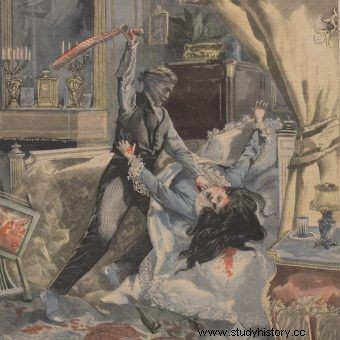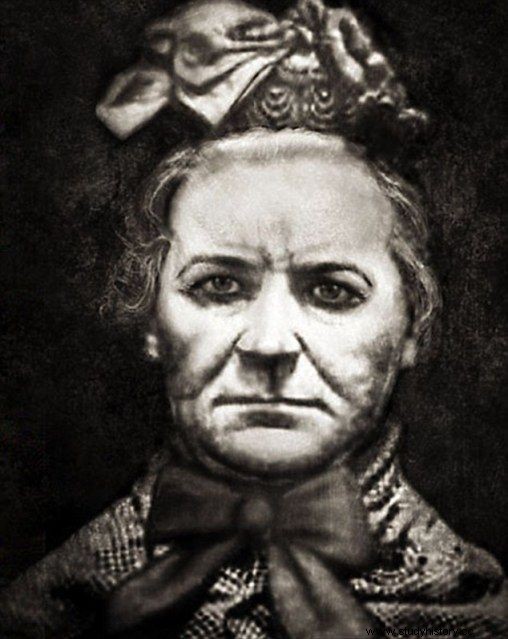Poisoning by plant alkaloids, quartering and boiling the bodies of victims, walling up the bodies under the floor - these are just some of the cases recorded in 19th century British criminal records. Cruel murders were carried out in the light of gas lamps, the perpetrators of which were not always caught, and the motives - fully explained.
The atmosphere favored the crime, especially in the capital of the empire. Until 1829, London lacked organized police forces, and until 1842, there were no investigative police. The figure of Jack the Ripper has become legendary, but it was not only the crimes in Whitechapel that shocked the public opinion of the time. Hear the stories that shocked the British public and spurred the development of forensics.
Victorian Angel
Early in the morning of June 30, 1860, Elizabeth Gough, the nanny of the Samuel and Mary Kent family, awoke to find that three-year-old Saville Kent's crib was empty. Convinced that it was the mother who took the boy to her, she knocked on her room an hour later. But Saville wasn't there either. Outraged Mrs. Kent reminded Nanny's sluggishness. An immediate search was ordered.

Victorian society read crime stories. The bloodier the more exciting.
The news of the disappearance of the three-year-old spread around the area. William Nutt and Thomas Benger, who lived nearby, decided to help. They began by combing the bushes next to the front driveway. At one point, Nutt walked over to the servants' outhouse hidden in the bushes. When she and Benger entered, they noticed a small pool of coagulated blood on the floor. They raised the toilet door and saw a bloody blanket and underneath it, Saville's body. It was established that at night someone had entered Gough's room, lifted the boy from the crib, and carried him to the outhouse. There he stabbed the child in the chest, cut his throat, and finally threw the body into the excrement.

In nineteenth-century families, appearances were often the most important. At all costs, they tried to hide the problems:conflicts, alcoholism, mental illness or acts of violence.
The circumstances indicated that the crime was committed by one of the household members. The murder mystery at the Road Hill house was quickly publicized - it was seen as an attack on the "sanctity of the hearth" and a threat to every English family. As Kate Summerscale writes in her book "The Suspicions of Mr. Whicher":
It has been found that a hermetic family, so respected by Victorian society, can harbor repressed, toxic and harmful emotions, emotional and sexual fumes. (…) The more the house fire was closed, the more dirt could be lurking inside.
Paradoxically, the investigation itself was also an attack, as it required stepping into a closely guarded sphere of privacy. For such a delicate matter, it was decided to assign an officer from London. The unblemished Inspector Jonathan Whicher was elected.
Whicher, after analyzing the facts, accused Saville's half-sister, 16-year-old Constance, of the crime. The girl was said to show symptoms of insanity, and according to some family friends, she was mistreated by her stepmother. The lack of conclusive evidence and Whicher's conflict with the local police, however, led Constance to be acquitted. The inspector himself was branded as the accuser of an innocent child and had to end his career in the police.

Portrait of Constance Kent. The public was convinced that the young girl was incapable of committing a cruel murder.
The truth came to light a few years later. In 1865, Constance pleaded guilty. The reasons for her behavior remained unclear.
Angel Maker
The situation of unmarried mothers in the second half of the nineteenth century was difficult not only for financial reasons, but also because of social stigma. So-called "baby farmers" rushed to help women who wanted to hide a shameful secret. These were people offering babysitting services for a fee. It was in their interest to get rid of the children as soon as possible. In practice, therefore, the "care" provided was limited to abandoning the charges and leaving them for certain death.
The most famous British "farmer" was Amelia Dyer, known as "the Angel Maker", and therefore "angel manufacturer". When, after her husband's death, she needed money quickly, at the urging of a midwife friend, she decided to open her own business.

Life in the 19th century was not easy for orphans and illegitimate children.
She promised her clients that she would provide their children with a safe and loving home. However, as the women left her doorstep, she watered the babies with a so-called "Mother's Friend" (the popular opium-based syrup that silenced babies crying because of hunger) and left them unattended while waiting for death. Soon, to speed up the process, she immediately began strangling the babies with sewing tape.
Dyer was suspicious of the police when one of the doctors raised concerns about her service. According to him, children too often (even by 19th-century standards) died under her care. Dyer was charged with negligence and sentenced to ... symbolic six months of hard labor.
After serving her sentence, she returned to business. This time, she did not inform doctors about the deaths, she often changed her places of stay and nicknames. Her murderous actions were revealed when a bag with the body of a baby was fished out of the Thames. Traces led investigators to Dyer's house. No direct evidence was found on the spot, but adoption contracts, sewing tape, and letters from mothers inquiring about the health of their children remained.

Photo of Amelia Dyer taken at Wells Asylum Prison in 1893.
Amelia Dyer was hanged in 1896. When asked to say the last words, she was to say:"I have nothing to say." It is believed that she murdered between 200 and 400 infants.
Doctor from Hell
Thomas Neil Cream was an outstandingly gifted student. Due to his extraordinary erudition, he gained the nickname "Mr. Encyclopedia" at the university. He graduated from McGill College in 1876, presenting a dissertation on chloroform and obtaining a doctorate in medicine.
Already during his studies, rumors started circulating that Cream is having an abortion and that patients who use his services often die. The same year he graduated from university, he married Flora Brooks, who was carrying his child. Flora died a year later. Officially - because of tuberculosis.
Cream decided to develop his career. He went to England to practice at Saint Thomas Hospital, then to Scotland to do research at the University of Edinburgh and qualify as a surgeon. After receiving new degrees, he returned to Ontario. There he undertook an abortion again. His career was interrupted by a terrifying discovery. The body of a pregnant woman, poisoned with chloroform, was found near the office where he worked. By some strange coincidence, Cream wasn't punished even then.

The nineteenth century is sometimes called the "golden age" of poisoners.
Probably in order to avoid further suspicion, he moved to Chicago. There he undertook the treatment of Daniel Stott, suffering from epilepsy. The medications were regularly taken by the patient's wife. As her visits to Cream grew more frequent and longer, Stott became suspicious. In response to his spouse's jealousy, the doctor decided to… add a little strychnine to the medicine.
While it was officially recognized that Stott had died from his illness, Cream wrote a letter to the coroner requesting the exhumation of the body. Poison was found in the deceased's stomach, and Cream was accused of murder at his own request. He was sentenced to life imprisonment, but released after ten years for good behavior.
After his release, he moved to London, where he rented a room on Lambeth Road, in a poor neighborhood. Only there he could fully develop his sadistic tendencies - began regularly poisoning prostitutes with strychnine. Four women fell victim to him. He would probably have avoided punishment again, had it not been for ... his overzealous willingness to help the police catch the murder mysterious perpetrator. He was hanged in 1892 and his last words "I am Kuba ..." were intended to imply that he was the legendary Ripper.
Delivered without delay
The end justifies the means, and science is undoubtedly a noble goal, as Robert Knox, a scientist at the University of Edinburgh probably thought, when in 1822 he established a secret organization called "Resurrectionists", illegally supplying research objects to the tables of anatomopathologists. His plans were thwarted by irritated residents, whose initiative put a special guard in the cemeteries and thus interrupted the delivery of the bodies for the practice sections.
The problem of the lack of research material for medical students was widely known - also to William Burke, who lived in a shelter run by William Hare. The sudden death of one of the inmates gave both men an idea. After the funeral, they dug up the body of the former roommate and took it to Dr. Knox, who, as predicted, paid them the money right away and did not ask about the origin of the body. From then on, Hare and Burke helped the people they met on the streets in their journey to the other world, and at night they met the doctor who assessed the "goods" delivered and paid the appropriate amount for it.

The scholars at the University of Edinburgh were desperate. Robert Knox did not ask where the research material came from.
The illegal practice appeared by accident when medical students recognized the body on the autopsy table as Deaf Jamie, a beggar known to the people of Edinburgh, who had been seen in perfect health the day before. Burke and Hare were arrested. Hare so zealously accused his partner that he was pardoned. Burke, on the other hand, found the scaffold and then - ironically - on the table as an object for an open autopsy.
Impatient teacher
Fourteen-year-old Reginald Channell Cancellor became a victim of the high-profile case known as the "Eastbourne manslaughter", which sparked a discussion about the use of corporal punishment in schools. The boy had a natural learning disability, possibly due to hydrocephalus. His teacher, Thomas Hopley, was entrusted with the task of making him study, even against himself. Hopley took this recommendation too literally.
The perpetrator himself drew suspicions. The teacher maintained that on the morning of April 22, 1860, he had entered Reginald's bedroom and only then discovered his dead body. The servants, however, testified against him:late in the evening of the previous day, the sounds of scuffling for almost an hour were heard.

Private teachers have not always been kinder than those working in public schools.
On the fatal morning, freshly laundered clothes arrived at the house, but the blood remained on the carpet, the sheets and some of the boy's clothes. Hopley didn't call the doctor right away, and he delayed sending the telegram to Father Reginald. Extensive injuries were found on the boy's body after being beaten with a candlestick and other tools. No one had any doubts - the teacher was accused of manslaughtering his student and sentenced to four years in prison.
Thomas Hopley was active in ending the heinous child labor of factories. After the case of Reginald's death was publicized, the press did not fail to remind him of his hypocrisy. So, almost a permanent feature of Victorian criminals.
Want to know more? Read about London as the capital of debauchery and prostitution
